Thinking about bringing a feline friend into your home, but envisioning a cuddly companion with a bit more to love? You’re not alone! Many cat lovers are drawn to Large House Cat Breeds, those magnificent felines that tip the scales at 20 pounds or more – significantly larger than the average domestic cat. While their impressive size certainly adds to their charm, it’s essential to understand that these gentle giants come with unique needs and considerations. From extra-large cat trees to carefully managed diets, providing the right environment is key to ensuring their health and happiness.
This guide will introduce you to ten remarkable large domestic cat breeds, each with its own distinctive personality and care requirements. We’ll delve into what makes them special, helping you decide if one of these supersized sweethearts is the perfect addition to your family.
Key Considerations for Large Cat Breeds
Before we dive into specific breeds, let’s highlight some important factors to keep in mind when considering a large house cat:
- Size Matters: While the average cat weighs between 8 and 12 pounds, these breeds can easily reach 20 pounds or more. This means they need larger everything – from litter boxes and scratching posts to cat carriers and beds.
- Sturdy Equipment: Forget flimsy cat trees! Large breeds require robust and stable furniture to accommodate their size and prevent accidents. Invest in heavy-duty scratching posts and cat trees built to withstand their weight.
- Dietary Needs: While more to cuddle is delightful, preventing obesity is crucial for their health. Large breeds are still prone to weight gain, which can lead to joint problems and other health issues. Careful portion control and a balanced diet are essential.
- Potential Health Concerns: Some large breeds are predisposed to certain health conditions like hip dysplasia and arthritis. Regular veterinary checkups and proactive care are vital to monitor and manage these potential issues.
Now, let’s meet these magnificent breeds!
1. Maine Coon: The Gentle Giant
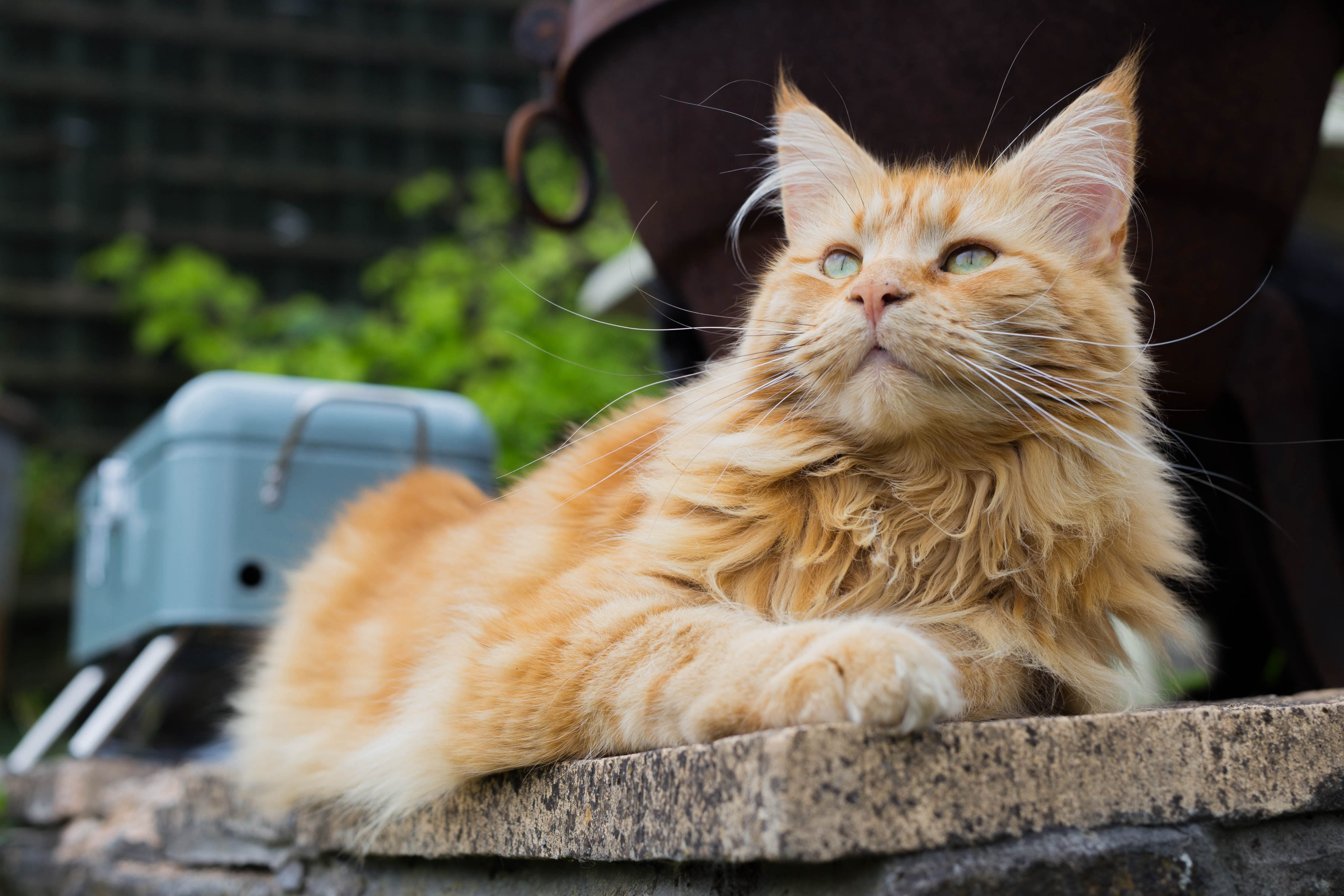 a big cat breed, an orange maine coon, lying down
a big cat breed, an orange maine coon, lying down
Alt text: A majestic orange Maine Coon cat lounges peacefully, showcasing its large size and fluffy coat, a quintessential example of a large house cat breed.
Weight: 8–18 pounds
The Maine Coon is arguably the most well-known large domestic cat breed, and for good reason. Often referred to as “gentle giants,” Maine Coons are renowned for their friendly, laid-back personalities and their striking appearance. Originating from Maine, USA, they are built to withstand harsh winters, sporting a thick, water-resistant coat and a bushy tail. Their intelligence and trainable nature also make them exceptionally excellent family pets, often described as dog-like in their loyalty and affection.
Caring for a Maine Coon requires understanding their size-related needs. They thrive with spacious litter boxes and sturdy scratching posts to accommodate their larger frames. Furthermore, they are predisposed to hip dysplasia, a hereditary condition affecting the hip joints. Regular veterinary checkups are crucial for monitoring their joint health, and consulting with your vet about proactive measures, such as joint supplements, can be beneficial.
2. Norwegian Forest Cat: The Mythical Climber
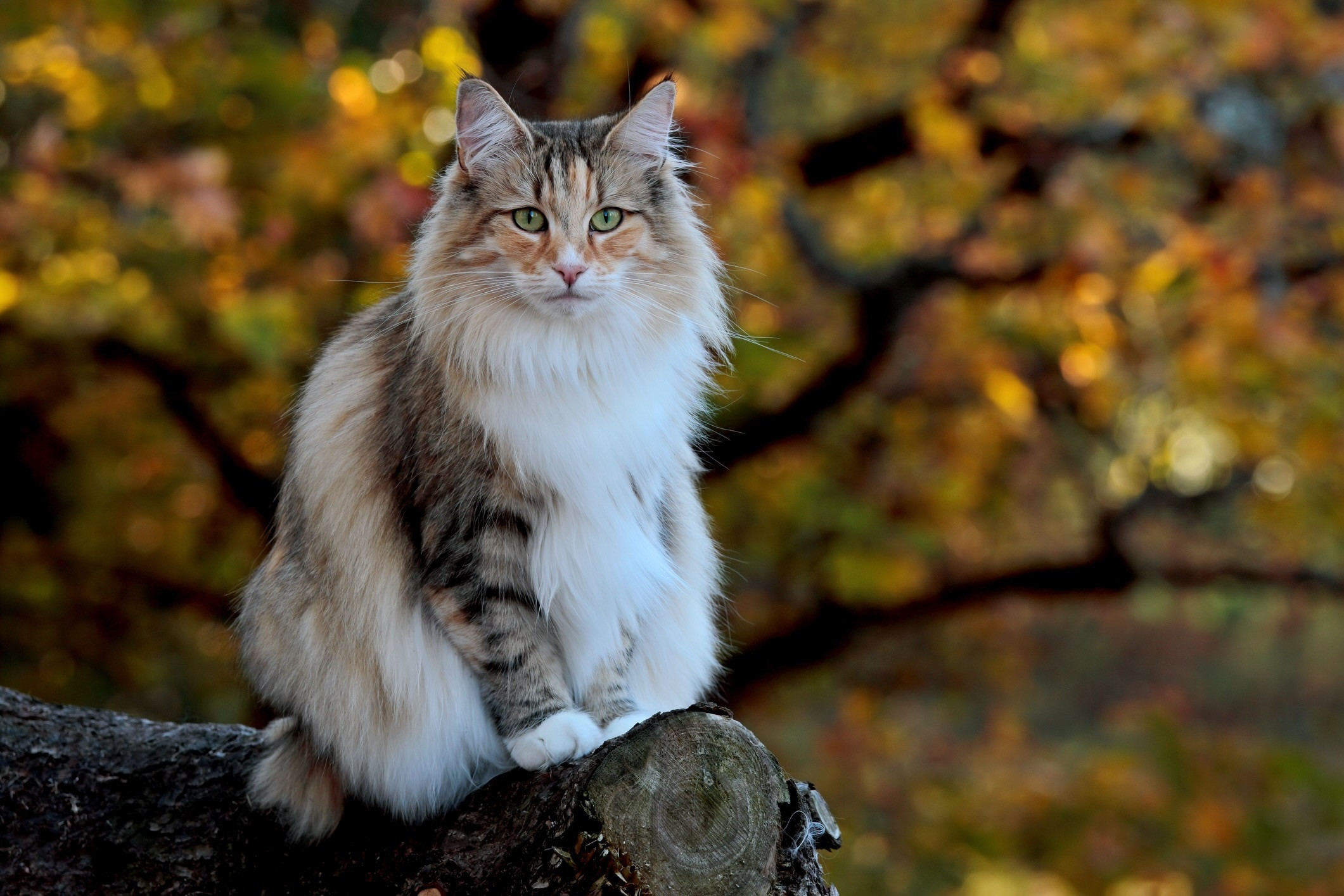 a calico norwegian forest cat, which is a big cat breed, sitting on a log
a calico norwegian forest cat, which is a big cat breed, sitting on a log
Alt text: A beautiful calico Norwegian Forest Cat, a large cat breed known for its thick fur and climbing abilities, perches gracefully on a log, showcasing its natural elegance.
Weight: 12–16 pounds
Don’t be deceived by their luxurious, dense fur – the Norwegian Forest Cat, affectionately nicknamed “Wegie,” is a truly substantial cat. Originating from Norway, as their name suggests, these cats are built for survival in cold climates with a thick double coat that provides exceptional insulation. They are natural climbers and explorers, possessing a strong, muscular build beneath all that fluff. Wegies are known for their independent yet affectionate nature, making them wonderful companions for those who appreciate a cat with a touch of wildness.
Their love for climbing means providing supportive cat trees and perches is essential to keep them happy and active. While generally healthy, their size does make them susceptible to conditions like hip dysplasia and arthritis. Maintaining a healthy weight is paramount for this fluffy cat breed to minimize strain on their joints and ensure a long, active life.
3. Siberian: The Russian National Treasure
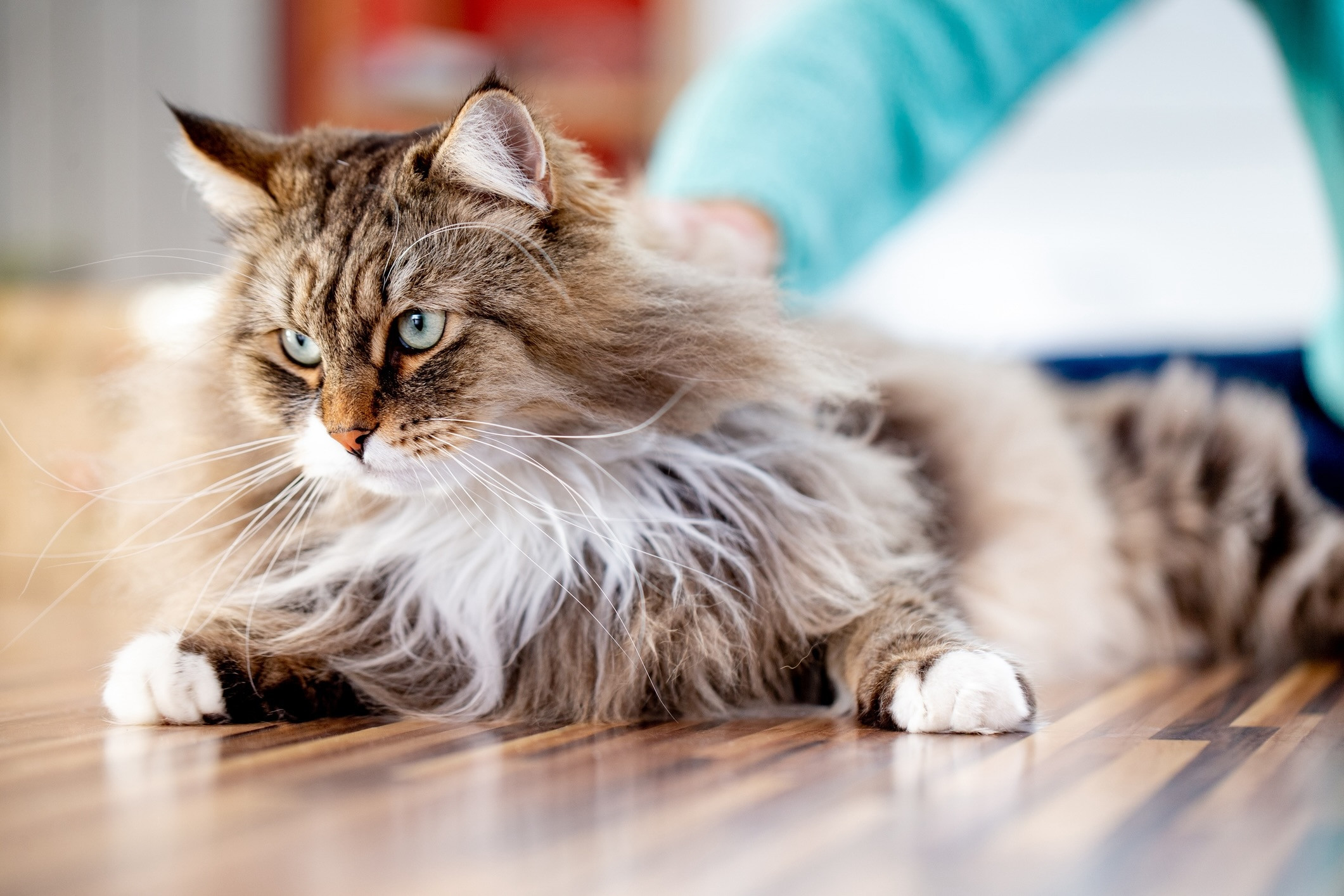 a big cat breed, the siberian, lying on the floor as someone pets him
a big cat breed, the siberian, lying on the floor as someone pets him
Alt text: A Siberian cat, a large and fluffy breed, relaxes on the floor while being gently petted, highlighting its affectionate nature and striking triple coat.
Weight: 12–15 pounds
The Siberian, Russia’s national cat, is a breed that exudes both beauty and resilience. Distinguished by their magnificent triple coat, designed to withstand the harsh Siberian winters, and their captivating, expressive eyes, Siberians are truly striking felines. Interestingly, this big cat breed is slow to mature, often taking up to five years to reach their full size and majestic potential. They are known for their playful and affectionate personalities, often forming strong bonds with their families.
Despite their playful nature, Siberians can be prone to obesity if not provided with enough activity. While they may enjoy cuddling sessions, it’s important to encourage daily playtime to keep them physically and mentally stimulated. Surprisingly, these kitties can be leash trained, offering another avenue for exercise and exploration. Regularly monitoring their weight and adjusting their diet as needed is key to maintaining their health.
4. Bengal: The Leopard Look-Alike
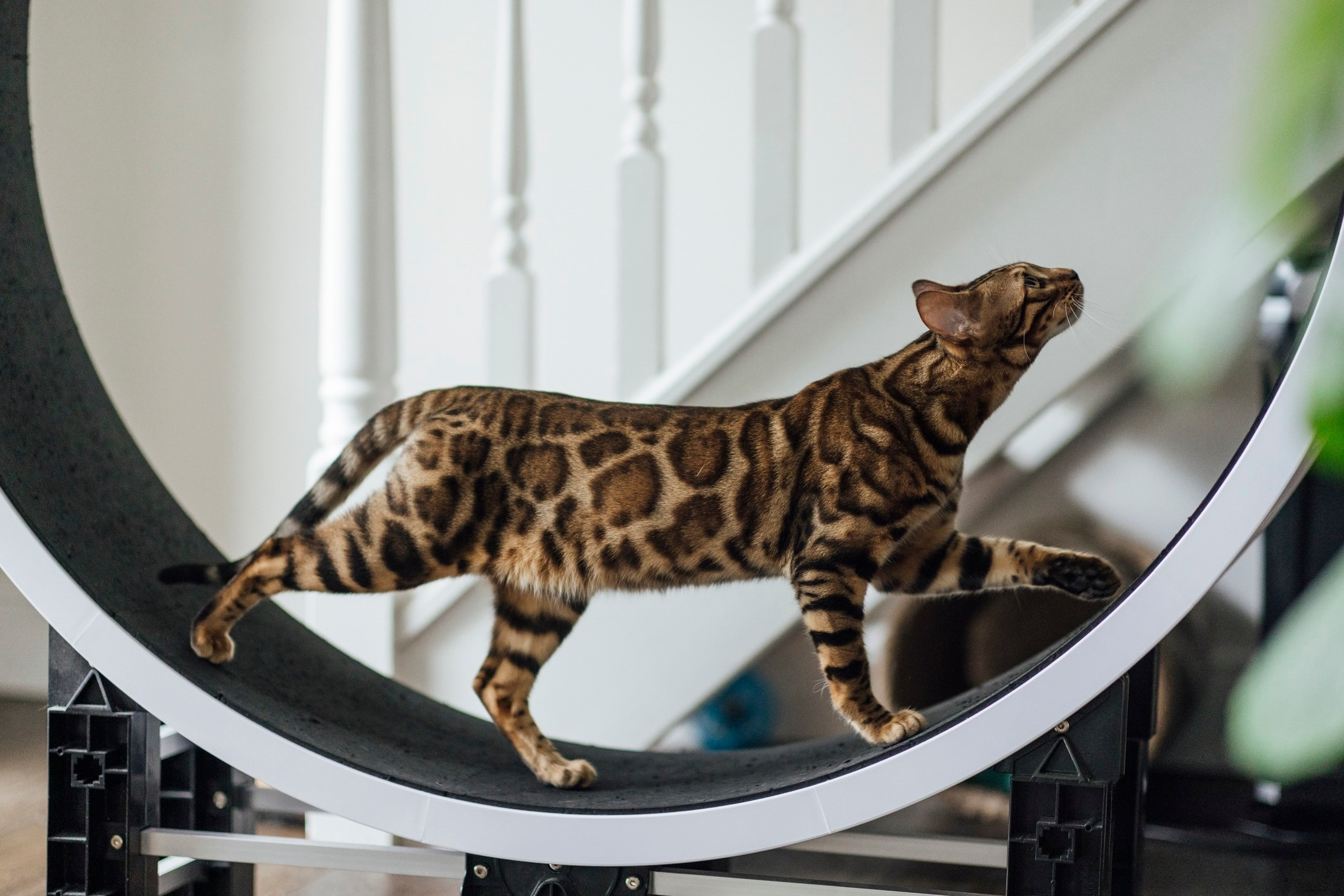 a big cat breed, a bengal cat, walking on a cat wheel
a big cat breed, a bengal cat, walking on a cat wheel
Alt text: A Bengal cat, a large and athletic breed with leopard-like spots, energetically walks on a cat wheel, demonstrating its high energy levels and need for exercise.
Weight: 8–15 pounds
The Bengal is a breed that captivates with its wild appearance and athletic prowess, reminiscent of a leopard. Developed by crossing domestic cats with Asian Leopard Cats, Bengals retain a striking spotted or marbled coat and a uniquely energetic personality. While they certainly appreciate a good nap as much as any cat, Bengals are exceptionally active and require ample vertical space to satisfy their jumping and climbing instincts. They are intelligent, curious, and often described as having a mischievous streak.
Bengals have a strong hunting drive and thrive on mental stimulation. Puzzle feeders and treat-dispensing toys are excellent tools to satisfy their predatory instincts and keep them entertained and engaged. Providing tall cat trees and shelves will allow them to explore their environment vertically and burn off energy.
5. Savannah: The Exotically Tall Breed
 a big cat breed, the savannah, lying on a chair
a big cat breed, the savannah, lying on a chair
Alt text: A Savannah cat, a strikingly tall and slender large cat breed, relaxes gracefully on a chair, highlighting its exotic appearance and long legs.
Weight: 12–25 pounds
The Savannah is a truly unique breed that could easily be imagined roaming the African Serengeti. A hybrid breed resulting from crossing a domestic cat with an African Serval, Savannahs are known for their exceptional height, slender build, and striking spotted coats. Despite their wild ancestry, Savannahs are known for their sweet and loyal temperaments and their boundless energy. They are highly intelligent and inquisitive, often forming very strong bonds with their owners.
Their impressive jumping ability – up to 8 feet! – means they require durable cat trees and secure shelves for safe climbing and exploration. Due to their hybrid nature, Savannah ownership might come with specific regulations depending on location, so it’s crucial to research local laws before considering this breed.
6. Ragdoll: The Gentle Giant with Blue Eyes
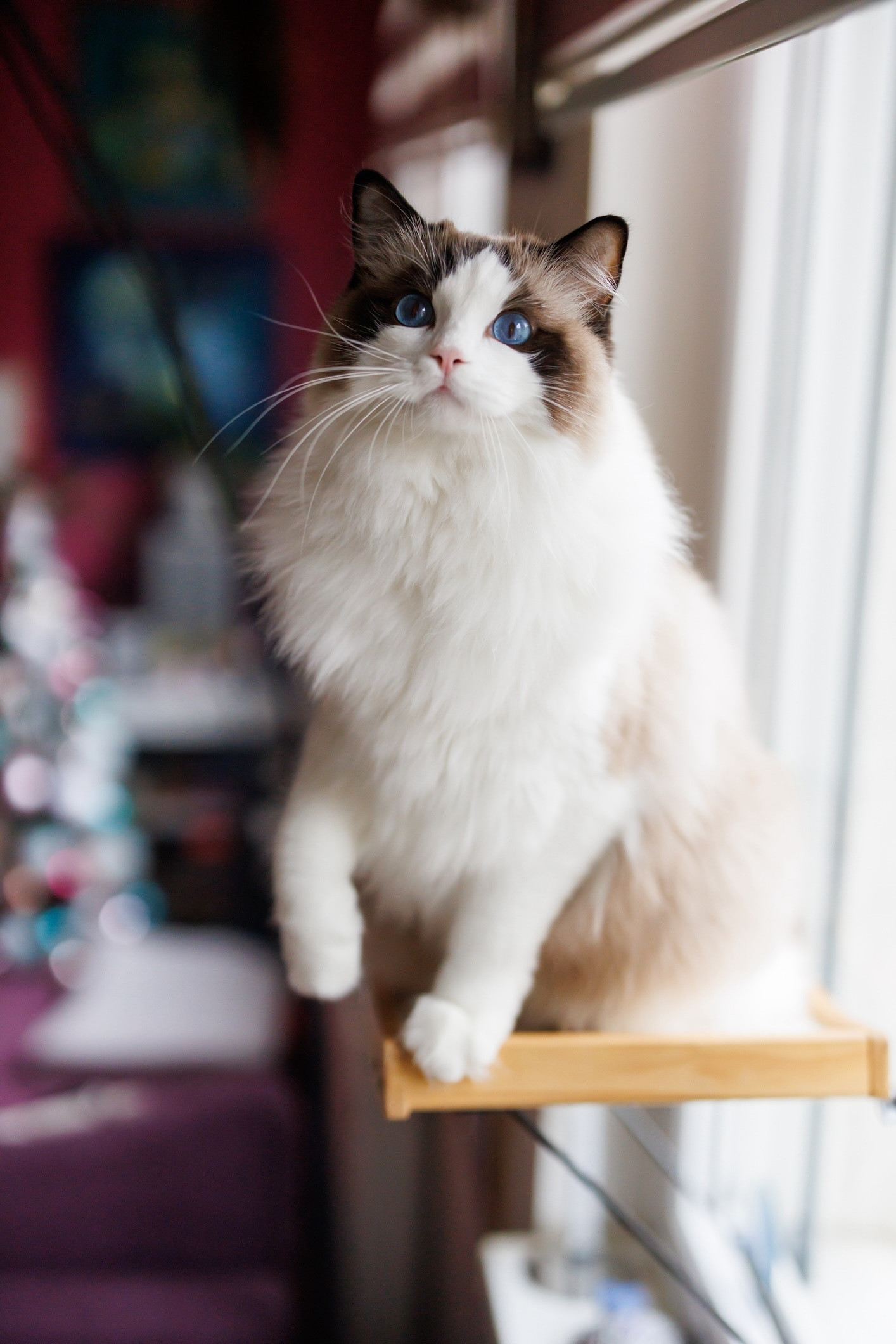 a big cat breed, the ragdoll, sitting on top of a cat tower
a big cat breed, the ragdoll, sitting on top of a cat tower
Alt text: A beautiful Ragdoll cat, a large breed with striking blue eyes and a semi-longhaired coat, sits regally atop a cat tower, showcasing its gentle demeanor.
Weight: 10–20 pounds
As their name suggests, the Ragdoll is known for going limp and floppy when held, embodying their sweet and docile nature. These large and beautiful cats are known for their striking blue eyes and semi-longhaired, silky coats. Ragdolls are exceptionally gentle and affectionate, making them excellent companions for families and individuals alike. While they are playful, they are not overly demanding and tend to be content lounging and cuddling with their humans. They typically don’t reach their full size or weight until around age 4, growing slowly and steadily.
Despite their relaxed nature, Ragdolls can be prone to weight gain if not properly managed. Portion control and regular playtime are important to prevent obesity and associated health issues like arthritis. Engage these laid-back felines in exercise with games of fetch and clicker training to keep them active and healthy.
7. RagaMuffin: The Sweet and Cuddly Relative
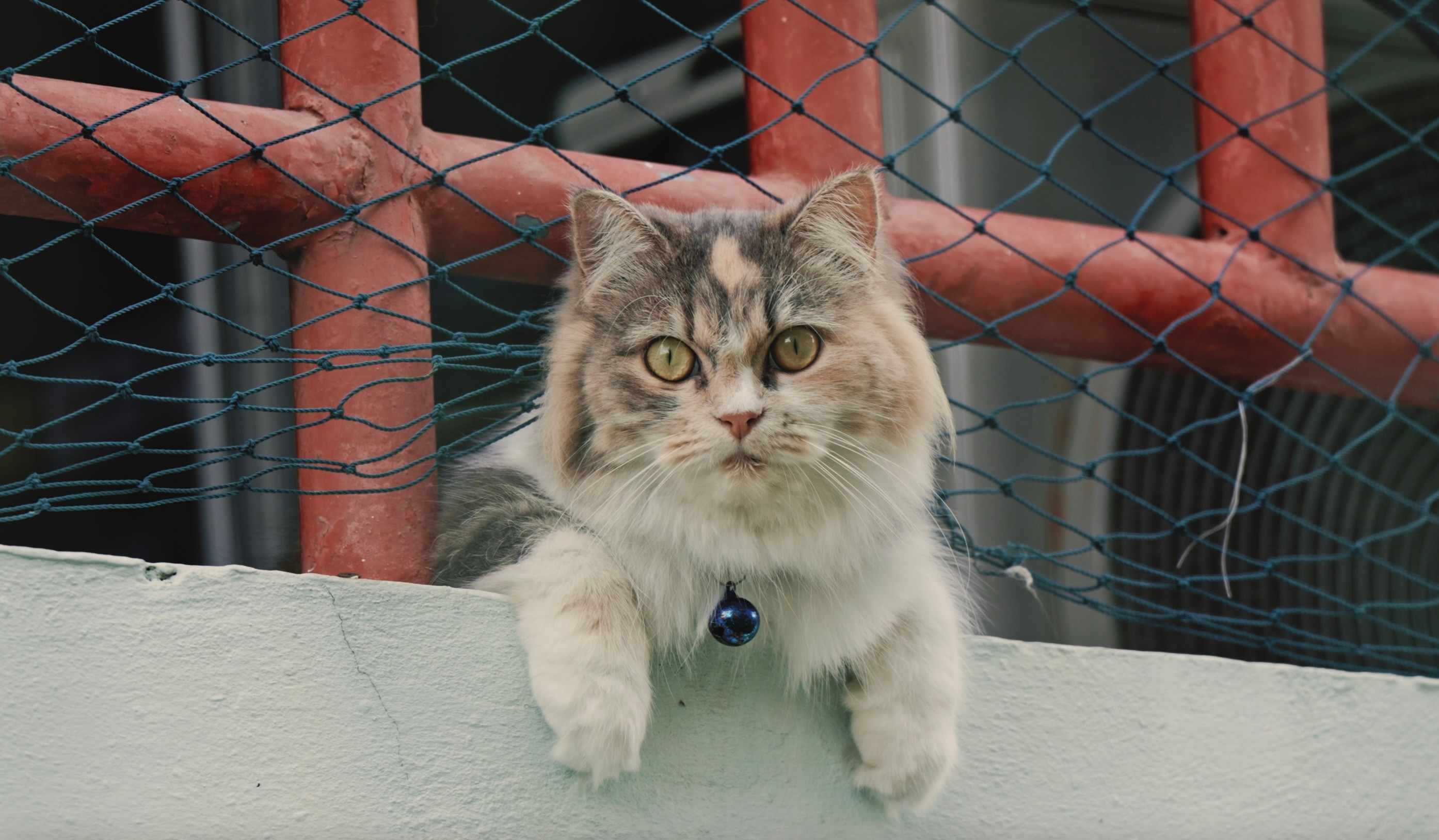 dilute calico ragamuffin, a big cat breed, lounging on a patio under a net
dilute calico ragamuffin, a big cat breed, lounging on a patio under a net
Alt text: A dilute calico RagaMuffin cat, a large and fluffy breed similar to the Ragdoll, relaxes comfortably on a patio, highlighting its cuddly nature and gentle disposition.
Weight: 10–20 pounds
Closely related to the Ragdoll, the RagaMuffin shares many of the same endearing qualities, including a gentle temperament and a large size. RagaMuffins are known for being exceptionally sweet, docile, and affectionate, making them wonderful lap cats and family pets. They are also slow to mature, reaching their full-grown size around 4 years old, similar to Ragdolls. This fluffy cat breed comes in a wide array of colors and patterns, adding to their visual appeal.
Being naturally big-boned, RagaMuffins require larger cat supplies to match their size as they grow. This includes jumbo cat trees, spacious litter boxes, and appropriately sized carriers for transport. Like other large breeds, they can develop arthritis as they age, making proper nutrition and exercise essential for maintaining joint health throughout their lives.
8. American Bobtail: The Bobbed-Tail Charmer
Alt text: A cute orange American Bobtail kitten, a large breed characterized by its short tail, stands inquisitively looking up, showcasing its playful and affectionate nature.
Weight: 7–16 pounds
Named for their distinctive short or “bobbed” tail, the American Bobtail is a breed known for its affectionate and active personality. These intelligent cats are often described as dog-like in their devotion and trainability. They are playful and enjoy interactive games and puzzles, making them engaging companions. American Bobtails are known to be adaptable and get along well with children and other pets.
The Bobtail’s signature short tail is due to a genetic mutation (the same gene responsible for the bobbed tail), which unfortunately can make them susceptible to spine and hip issues. Feeding an AAFCO-compliant diet is crucial for these kitties to help them maintain an ideal weight and support their overall health, particularly their skeletal system.
9. British Shorthair: The Calm and Easygoing Companion
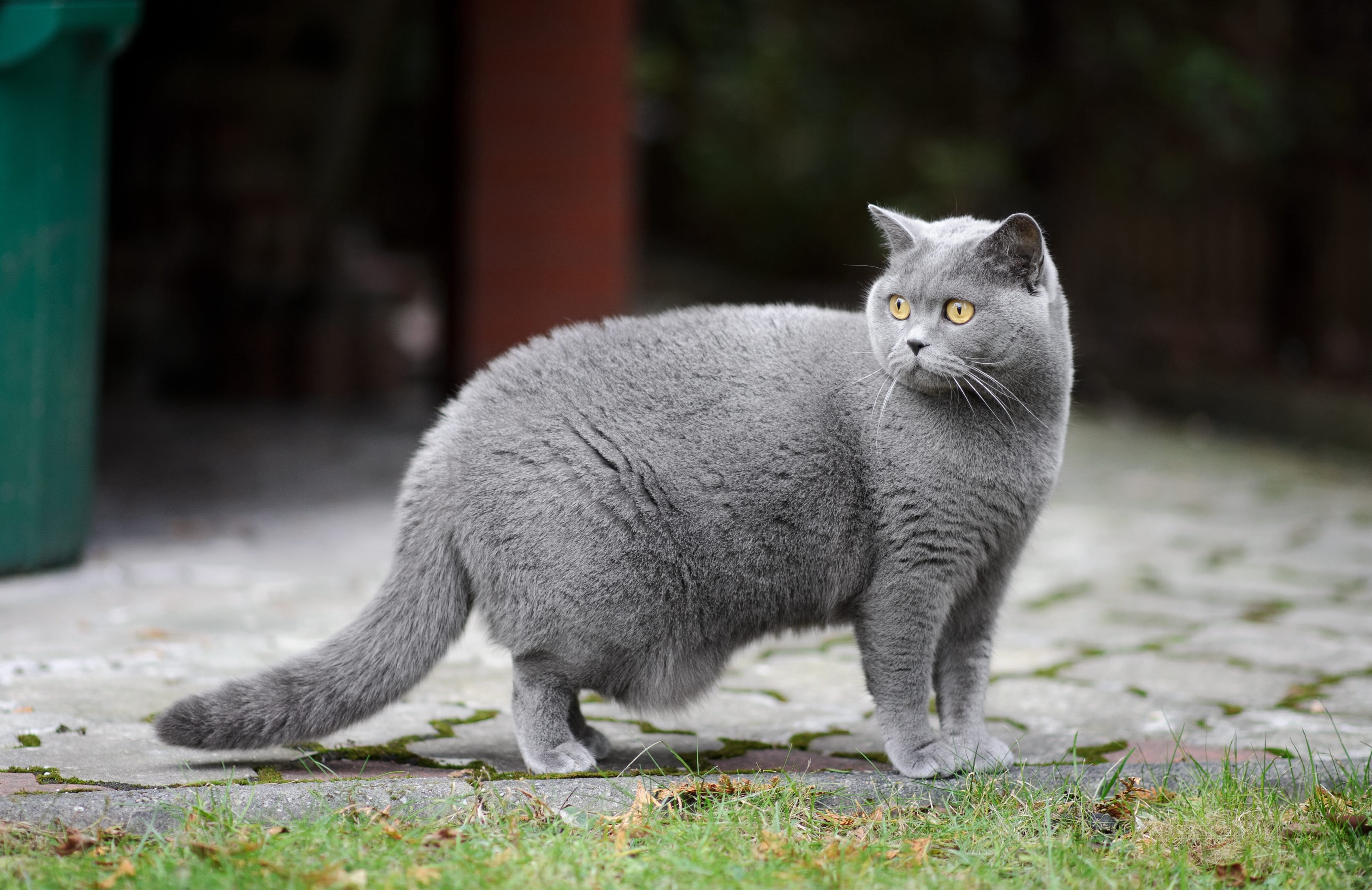 a blue british shorthair, a big cat breed, standing outside
a blue british shorthair, a big cat breed, standing outside
Alt text: A blue British Shorthair cat, a large and sturdy breed known for its calm demeanor, stands outdoors, showcasing its plush coat and gentle expression.
Weight: 7–17 pounds
The British Shorthair has earned a reputation as a calm, adaptable, and easygoing cat breed. With their round faces, plush coats, and sturdy builds, they are often described as teddy bear-like. British Shorthairs are known for their independent nature, but they are also affectionate and enjoy spending time with their families. They are generally quiet and undemanding, making them excellent companions for apartment living or quieter households.
While they are not overly energetic, British Shorthairs do need encouragement to stay active, as they tend to prefer lounging to leaping. Interactive toys like feather wands and catnip can help motivate them to move and play. Portion control and minimizing treats are important to prevent weight gain, which could put strain on their joints over time.
10. Turkish Van: The Water-Loving Swimmer
 a big cat, the turkish van, sitting and pawing in front of a black background
a big cat, the turkish van, sitting and pawing in front of a black background
Alt text: A Turkish Van cat, a large breed with a distinctive white and colored pattern, sits and playfully paws, highlighting its active nature and rumored love for water.
Weight: 10–20 pounds
One of the most intriguing large house cat breeds, Turkish Vans are not only notable for their size but also for their surprising affinity for water. Originating from the Lake Van region of Turkey, these cats are known for their distinctive color pattern – white bodies with color restricted to the head and tail – and their muscular, substantial builds. Turkish Vans are active, intelligent, and curious cats who enjoy playing and exploring.
Whether they’re splashing in pet water fountains or investigating the bathtub, these water-loving felines need plenty of enrichment to channel their energy. Tall cat trees, shelves, and scratching posts are essential, and regular exercise will help prevent weight gain and support healthy joints throughout their active lives.
Are Large House Cat Breeds Right for You?
Large house cat breeds offer a unique and rewarding experience for cat lovers. Their impressive size is matched by their often gentle and affectionate personalities. However, it’s crucial to remember that welcoming a large breed into your home is a commitment that requires careful consideration of their specific needs.
If you have the space, resources, and dedication to provide for a large cat breed, you’ll be rewarded with a loving, loyal, and truly magnificent companion for years to come. Consider your lifestyle, living situation, and ability to meet their needs before making your decision, and you’ll be well on your way to finding the perfect gentle giant to enrich your life.
WRITTEN BY
Shannon Willoby
Freelance Writer

